To drivers it's an insult; to operators it's a compliment.
Page 119
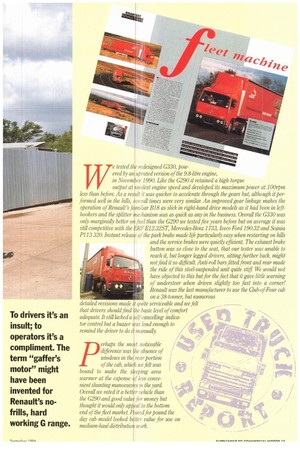
Page 118

Page 120
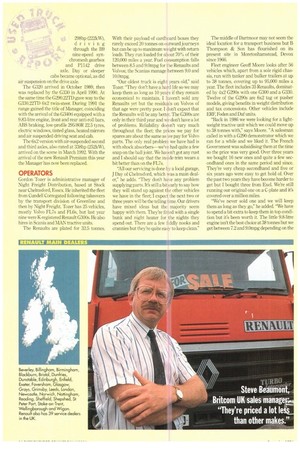
Page 121
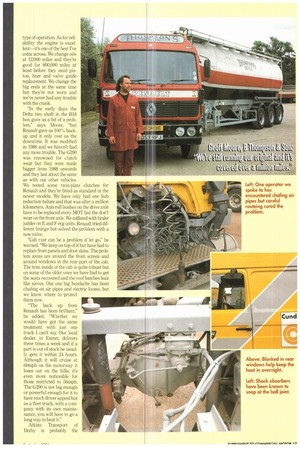
Page 122
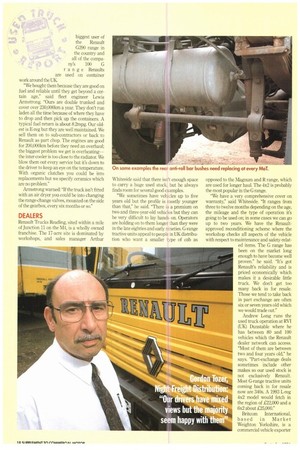
Page 123
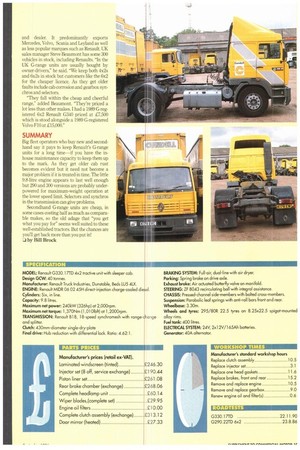
If you've noticed an error in this article please click here to report it so we can fix it.
The term "gaffer's motor" might have been invented for Renault's nofrills, hard working G range.
• The G290, built in the UK at Dunstable, was to be Renault's answer to the fleet market when it was introduced back in 1985. It was light and, with a revamped Club-of-Four cab, had a specification and price that looked right for the distribution sector. The Renault Manager, a development of the G Series, dates back to 1991 in France, since when 80,000 have been sold as rigids and artics throughout Europe. In France the Manager 34() takes 60% of its market. The G range/Manager has been less successful in the UK, but 1,596 have been sold over here since 1991.
EVOLUTION
The G290 17TD 4x2 tractive unit was launched on to the UK market in November 1985 alongside the 6x2 G290.22TD. The two models shared a 287hp (214kW) 9.8-litre sixcylinder engine, 18-speed transmission and sleeper cab. In May 1990 the 4x2 was replaced by the G300 17TD with its engine uprated to 298hp (222kW), driving through the B9 nine-speed synchromesh gearbox and P1142 drive axle. Day or sleeper cabs became optional, as did air suspension on the drive axle.
The G320 arrived in October 1989, then was replaced by the G330 in April 1990. At the same time the G290.22TD gave way to the G330.227D 6x2 twin-steer. During 1991 the range gained the title of Manager, coinciding with the arrival of the G340ti equipped with a 9.83-litre engine, front and rear anti-roll bars, ABS braking, low-profile 295/80R 22.5 tyres, electric windows, tinted glass, heated mirrors and air suspended driving seat and cab.
The 6x2 version with air-suspended second and third axles, also rated at 338hp (252kW), arrived on the scene in March 1992. With the arrival of the new Renault Premium this year the Manager has now been replaced.
OPERATORS
Gordon Tozer is administrative manager of Night Freight Distribution, based at Stock near Chelmsford, Essex. He inherited the fleet from Cundell Corregated following takeovers by the transport division of Greenline and then by Night Freight. Tozer has 25 vehicles, mostly Volvo His and FL6s, but last year nine were K-registered Renault G300s. He also hires in Scania and MAN tractive units.
The Renaults are plated for 32.5 tonnes.
With their payload of cardboard boxes they rarely exceed 20 tonnes on outward journeys but can be up to maximum weight with return loads. They run loaded for about 70% of their 120,000 miles a year. Fuel consumption falls between 8.5 and 9.0mpg for the Renaults and Volvos; the Scanias manage between 9.0 and 10.0mpg.
"Our oldest truck is eight years old," said Tozer. "They don't have a hard life so we may keep them as long as 10 years if they remain economical to maintain. I haven't sold any Renaults yet but the residuals on Volvos of that age were pretty poor. I don't expect that the Renaults will be any better. The G300s are only in their third year and we don't have a lot of problems. Reliability doesn't vary much throughout the fleet; the prices we pay for spares are about the same as we pay for Volvo parts. The only real problem we have had is with shock absorbers—we've had quite a few snap on the ball joint. We haven't got any rust and I should say that the inside trim wears a bit better than on the Ms.
"All our servicing is done by a local garage, J Day of Chelmsford, which was a main dealer," he adds. "They don't have any problem supplying parts. It still a bit early to say how they will stand up against the other vehicles we have in the fleet; I expect the next two or three years will be the telling time. Our drivers have mixed ideas but the majority seem happy with them. They're fitted with a single bunk and night heater for the nights they spend out. There are a few fiddly nooks and crannies but they're quite easy to keep clean." The middle of Dartmoor may not seem the ideal location for a transport business but B Thompson & Son has flourished on its present site in Moretonhamstead, Devon since 1966.
Fleet engineer Geoff Moore looks after 56 vehicles which, apart from a sole rigid chassis, run with tanker and bulker trailers at up to 38 tonnes, covering up to 95,000 miles a year, The fleet includes 35 Renaults, dominated by 4x2 G290s with one G300 and a G330. Twelve of the G290s are 6x2 tag or pusher models, giving benefits in weight distribution and tax concessions. Other vehicles include ERF, Foden and Daf units.
"Back in 1986 we were looking for a lightweight tractive unit which we could move up to 38 tonnes with," says Moore. "A salesman called in with a G290 demonstrator which we ran for a while and we liked it. The French Government was subsidising them at the time so the price was very good. Over three years we bought 16 new ones and quite a few secondhand ones in the same period and since. They're very cheap secondhand and five or six years ago were easy to get hold of. Over the past two years they have become harder to get but I bought three from Exel. We're still running our original one on a C-plate and it's covered over a million miles.
"We've never sold one and we will keep them as long as they go," he added. "We have to spend a bit extra to keep them in top condition but it's been worth it. The little 9.8-litre engine isn't the best choice at 38 tonnes but we get between 7.2 and 9.0mpg depending on the
type of operation. As for reliability the engine is excellent—it's one of the best I've come across. We change oils at 12000 miles and they're good for 800,000 miles at least before they need piston, liner and valve guide replacement. We change the big ends at the same time but they're not worn and we've never had any trouble with the crank.
"In the early days the Delta two shaft in the 1318 box gave us a bit of a problem," says Moore, "but Renault gave us 100% backup and it only cost us the downtime. It was modified in 1988 and we haven't had any more trouble. The G290 was renowned for clutch wear but they were made bigger from 1988 onwards and they last about the same as with our other vehicles. We tested some twin-plate clutches for Renault and they're fitted as standard in the newer models. We have only had one hub reduction failure and that was after a million kilometers. Anti-roll bushes on the drive axle have to be replaced every MOT but the don't wear on the front axle. We suffered with brake judder on E and F-reg units. Renault tried different linings but solved the problem with a new valve.
"Cab rust can be a problem if let go," he warned. "We keep on top of it but have had to replace front panels and door skins. The problem areas are around the front screen and around windows in the rear part of the cab. The trim inside of the cab is quite robust but on some of the older ones we have had to get the seats recovered and the roof hatches leak like sieves. Our one big headache has been chafing on air pipes and electric looms, but we know where to protect them now "The back up from Renault has been brilliant," he added. "Whether we would have got the same treatment with just one truck I can't say. Our local dealer, in Exeter, delivers three times a week and if a part is out of stock he usually gets it within 24 hours. Although it will cruise at 60mph on the motorway it loses out on the hills; it's even more noticeable for those restricted to 56mph. The G290 is not big enough or powerful enough for it to have much driver appeal but as a fleet truck, with a company with its own maintenance, you will have to go a long way to beat it."
Atkins Transport of Derby is probably the biggest user of the Renault G290 range in the country and all of the company's 100 G range Renaults are used on container work around the LTK "We bought them because they are good on fuel and reliable until they get beyond a certain age," said fleet engineer Lewis Armstrong. "Ours are double trunked and cover over 230,000km a year. They don't run laden all the time because of where they have to drop and then pick up the containers. A typical fuel return is about 8.2mpg. Our oldest is E-reg but they are well maintained. We sell them on to sub-contractors or back to Renault as part chop. The engines are good for 200,000km before they need an overhaul; the biggest problem we get is overheating— the inter-cooler is too close to the radiator. We blow them out every service but it's down to the driver to keep an eye on the temperature. With organic clutches you could be into replacements but we specify ceramics which are no problem."
Armstrong warned: "If the truck isn't fitted with an air dryer you could be into changing the range-change valves, mounted on the side of the gearbox, every six months or so."
DEALERS
Renault Trucks Reading. sited within a mile of Junction 11 on the M4, is a wholly owned franchise. The 17-acre site is dominated by workshops, and sales manager Arthur
Whiteside said that there isn't enough space to carry a huge used stock, but he always finds room for several good examples.
"We sometimes have vehicles up to five years old but the profile is mostly younger than that," he said. "There is a premium on two and three-year-old vehicles but they can be very difficult to lay hands on. Operators are holding on to them longer than they were in the late eighties and early nineties. G-range tractive units appeal to people in UK distribution who want a smaller type of cab as opposed to the Magnum and R range, which are used for longer haul. The 4x2 is probably the most popular in the Grange.
"We have a very comprehensive cover on warranty," said Whiteside. "It ranges from three to twelve months depending on the age, the mileage and the type of operation it's going to be used on; in some cases we can go up to two years. We have the Renaultapproved reconditioning scheme where the workshop checks all aspects of the vehicle with respect to maintenance and safety-related items. The G range has been on the market long enough to have become well proven." he said. "It's got Renault's reliability and is priced economically which makes it a desirable little truck. We don't get too many back in for resale. Those we tend to take back in part exchange are often six or seven years old which we would trade out."
Andrew Long runs the used truck operation at RVI (UK) Dunstable where he has between 80 and 100 vehicles which the Renault dealer network can access. "Most of them are between two and four years old," he says. "Part-exchange deals sometimes include other makes so our used stock is not exclusively Renault. Most G-range tractive units coming back in for resale now are 340s. A 1993 L-reg 4x2 model would fetch in the region of £22,000 and a 6x2 about £25,000."
Britcom International, based in Market Weighton Yorkshire, is a commercial vehicle exporter and dealer. It predominantly exports Mercedes, Volvo, Scania and Leyland as well as less popular marques such as Renault. UK sales manager Steve Beaumont has some 300 vehicles in stock, including Renaults. "In the UK Grange units are usually bought by owner-drivers," he said. "We keep both 4x2s and 6x2s in stock but customers like the 6x2 for the cheaper licence. As they get older faults include cab corrosion and gearbox synchros and selectors.
"They fall within the cheap and cheerful range," added Beaumont. "They're priced a lot less than other makes. I had a 1989 G-registered 6x2 Renault G340 priced at £7,500 which is stood alongside a 1989 G-registered Volvo F10 at £15,000."
SUMMARY
Big fleet operators who buy new and secondhand say it pays to keep Renault's G-range units for a long time—if you have the inhouse maintenance capacity to keep them up to the mark. As they get older cab rust becomes evident but it need not become a major problem if it is treated in time. The little 9.8-litre engine appears to last well enough but 290 and 300 versions are probably underpowered for maximum-weight operation at the lower speed limit. Selectors and synchros in the transmission can give problems.
Secondhand Grange units are cheap, in some cases costing half as much as comparable makes, so the old adage that "you get what you pay for" seems well suited to these well-established tractors. But the chances are you'll get back more than you put in!
by Bill Brock
SPECIFICATION
MODEL: Renault G330.17TD 4x2 tractive unit with sleeper cab.
Design GCW: 40 tonnes.
Manufacturer: Renault Truck Industries, Dunstable, Beds LU5 4LX,
ENGINE: Renault MIDR 06 02 451-t direct-injection charge-cooled dies-d
Cylinders: Six, in line.
Capacity: 9.8 litres.
Maximum net power: 240kW1326hp) at 2,000rpm.
Maximum net torque: 1,370Nm (1,01016ft) at 1,2000rpm.
TRANSMISSION: Renault B18, 18-speed synchromesh with range-cl.a je
and splitter Clutch: 430mm-dameter single-dry-plate Final drive: Hub reduction with differential lock. Ratio: 4.62:1 BRAKING SYSTEM: Full-air, dual-line with air dryer.
Parking: Spring brake on drive axle.
Exhaust brake: Air actuated butterfly valve on manifold.
STEERING: ZF 8043 recirculating ball with integral assistance.
CHASSIS: Pressed-channel side-members with bolted cross-members.
Suspension: Parabolic leaf springs with anti-roll bars front and rear.
Wheelbase: 3.30m.
Wheels and tyres: 295/80R 22,5 lyres on 8.25x22.5 spigot-mounted
alloy rims.
Fuel tank: 400 Litres.
ELECTRICAL SYSTEM: 24V, 2x12V/165Ah batteries
Generator: 40A alternator. WORKSHOP TIMES
Manufacturer's standard workshop hours Replace clutch assembly 10.5 Replace injector set 3.1 Replace one head gaskets 11.6 Replace brakes, front and rear 15.2 Remove and replace engine 10.5 Remove and replace gearbox 9,0 Renew engine oil and filter(s) 0.6
• • DTESTS
G330,17TD 22.11.90
G290.22TD 6x2 23.8.86








































































































































